Operations & Project Management: Dyson Case Study - BTEC HND Analysis
VerifiedAdded on 2023/06/11
|20
|6077
|309
Report
AI Summary
This report provides a comprehensive analysis of operations and project management principles within the context of Dyson, a leading manufacturer of home appliances. Part 1 delves into the company's background, contrasting operation with operations management, reviewing the implementation of operations management principles such as lean manufacturing, agile manufacturing, and flexible specialism. It assesses how well Dyson's operations management meets organizational requirements like cost, quality, and efficiency, and discusses continuous improvement and lean principles, including Kaizen, Just-in-Time (JIT), and simultaneous engineering, offering recommendations for improvement. Part 2 focuses on project management, providing a case study overview, explaining each stage of the Project Life Cycle (PLC) with supporting documentation, analyzing project methodologies and tools, and critically evaluating the effectiveness of the PLC using relevant theories and models. The report concludes with insights into enhancing Dyson's operational and project management strategies.
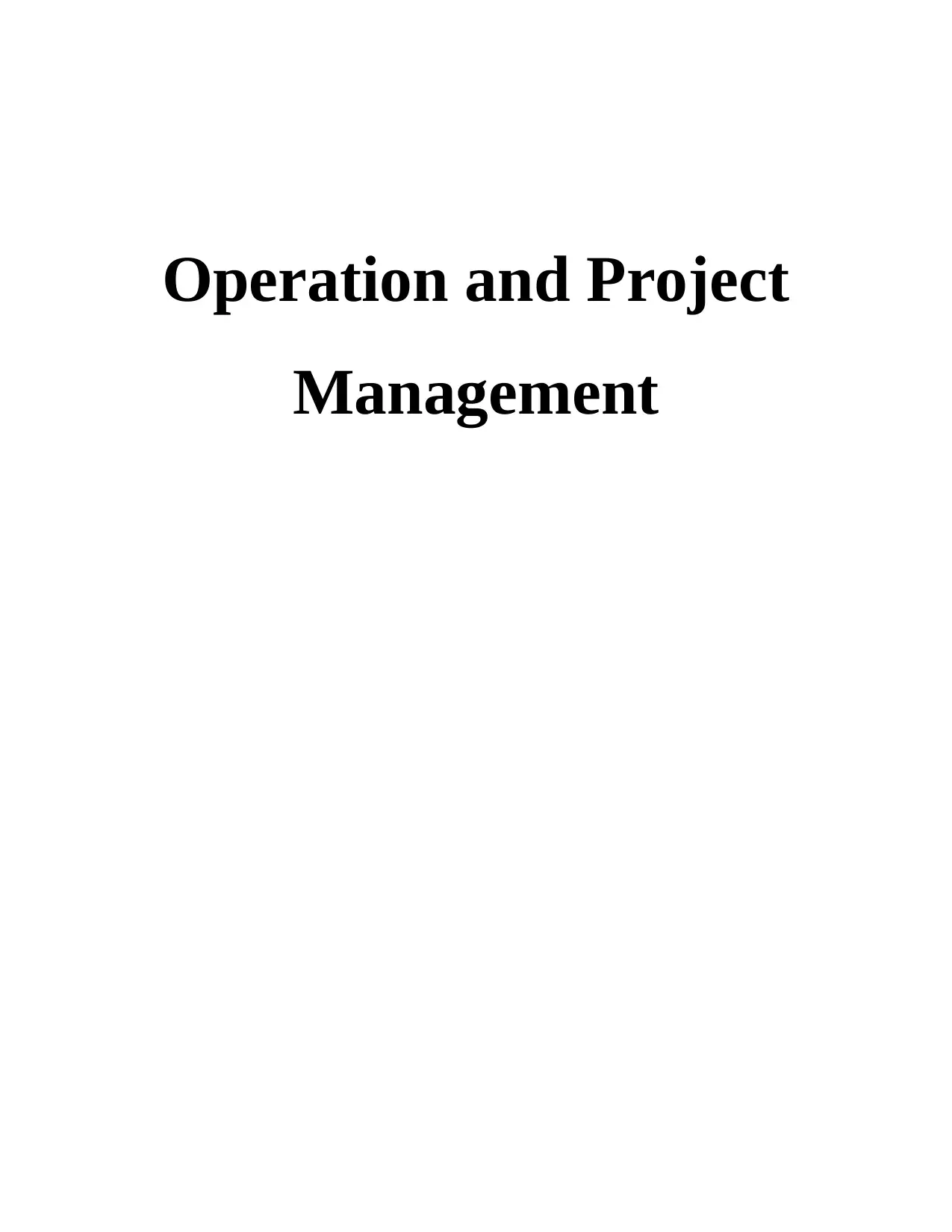
Operation and Project
Management
Management
Paraphrase This Document
Need a fresh take? Get an instant paraphrase of this document with our AI Paraphraser

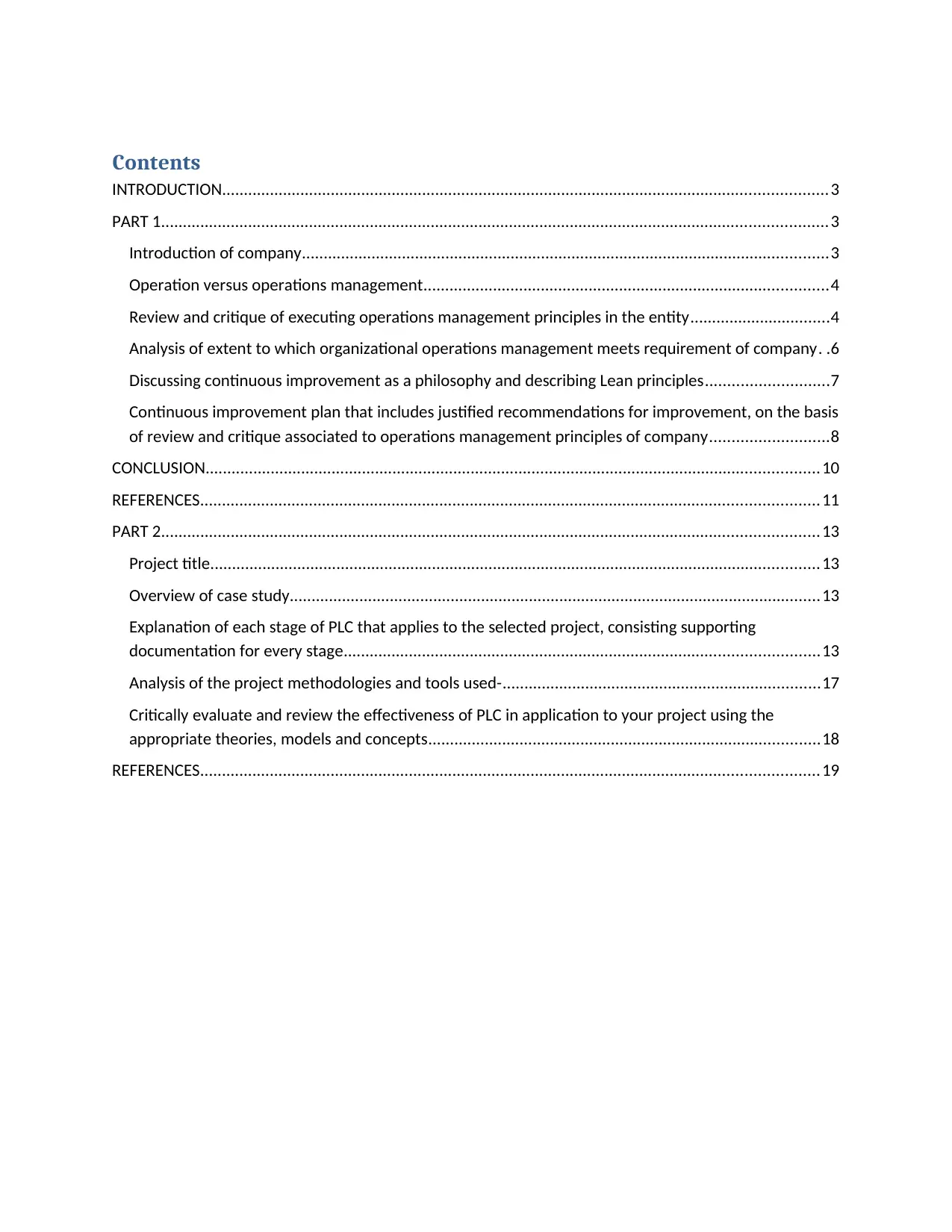
Contents
INTRODUCTION...........................................................................................................................................3
PART 1.........................................................................................................................................................3
Introduction of company.........................................................................................................................3
Operation versus operations management.............................................................................................4
Review and critique of executing operations management principles in the entity................................4
Analysis of extent to which organizational operations management meets requirement of company. .6
Discussing continuous improvement as a philosophy and describing Lean principles............................7
Continuous improvement plan that includes justified recommendations for improvement, on the basis
of review and critique associated to operations management principles of company...........................8
CONCLUSION.............................................................................................................................................10
REFERENCES..............................................................................................................................................11
PART 2.......................................................................................................................................................13
Project title............................................................................................................................................13
Overview of case study..........................................................................................................................13
Explanation of each stage of PLC that applies to the selected project, consisting supporting
documentation for every stage.............................................................................................................13
Analysis of the project methodologies and tools used-.........................................................................17
Critically evaluate and review the effectiveness of PLC in application to your project using the
appropriate theories, models and concepts..........................................................................................18
REFERENCES..............................................................................................................................................19
INTRODUCTION...........................................................................................................................................3
PART 1.........................................................................................................................................................3
Introduction of company.........................................................................................................................3
Operation versus operations management.............................................................................................4
Review and critique of executing operations management principles in the entity................................4
Analysis of extent to which organizational operations management meets requirement of company. .6
Discussing continuous improvement as a philosophy and describing Lean principles............................7
Continuous improvement plan that includes justified recommendations for improvement, on the basis
of review and critique associated to operations management principles of company...........................8
CONCLUSION.............................................................................................................................................10
REFERENCES..............................................................................................................................................11
PART 2.......................................................................................................................................................13
Project title............................................................................................................................................13
Overview of case study..........................................................................................................................13
Explanation of each stage of PLC that applies to the selected project, consisting supporting
documentation for every stage.............................................................................................................13
Analysis of the project methodologies and tools used-.........................................................................17
Critically evaluate and review the effectiveness of PLC in application to your project using the
appropriate theories, models and concepts..........................................................................................18
REFERENCES..............................................................................................................................................19
⊘ This is a preview!⊘
Do you want full access?
Subscribe today to unlock all pages.

Trusted by 1+ million students worldwide
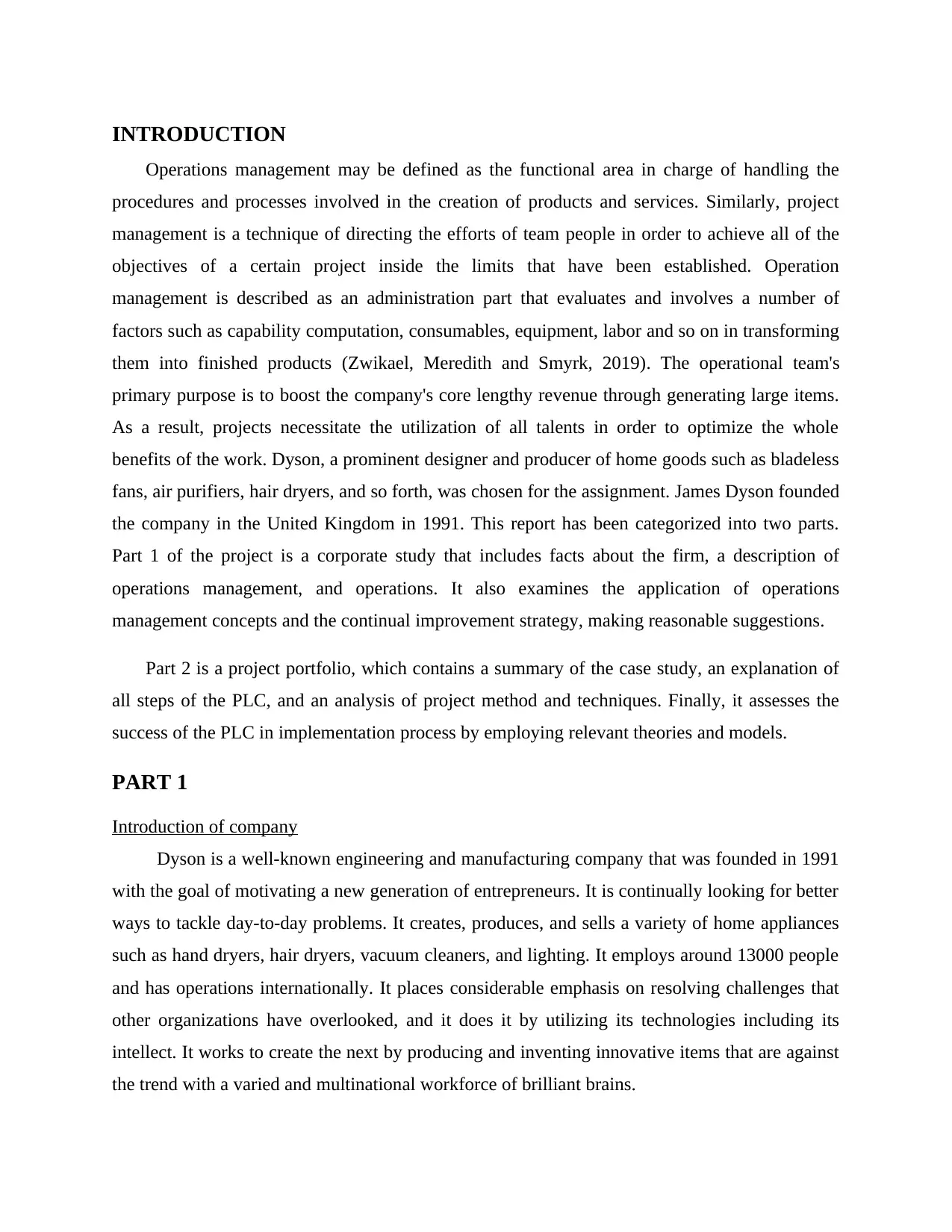
INTRODUCTION
Operations management may be defined as the functional area in charge of handling the
procedures and processes involved in the creation of products and services. Similarly, project
management is a technique of directing the efforts of team people in order to achieve all of the
objectives of a certain project inside the limits that have been established. Operation
management is described as an administration part that evaluates and involves a number of
factors such as capability computation, consumables, equipment, labor and so on in transforming
them into finished products (Zwikael, Meredith and Smyrk, 2019). The operational team's
primary purpose is to boost the company's core lengthy revenue through generating large items.
As a result, projects necessitate the utilization of all talents in order to optimize the whole
benefits of the work. Dyson, a prominent designer and producer of home goods such as bladeless
fans, air purifiers, hair dryers, and so forth, was chosen for the assignment. James Dyson founded
the company in the United Kingdom in 1991. This report has been categorized into two parts.
Part 1 of the project is a corporate study that includes facts about the firm, a description of
operations management, and operations. It also examines the application of operations
management concepts and the continual improvement strategy, making reasonable suggestions.
Part 2 is a project portfolio, which contains a summary of the case study, an explanation of
all steps of the PLC, and an analysis of project method and techniques. Finally, it assesses the
success of the PLC in implementation process by employing relevant theories and models.
PART 1
Introduction of company
Dyson is a well-known engineering and manufacturing company that was founded in 1991
with the goal of motivating a new generation of entrepreneurs. It is continually looking for better
ways to tackle day-to-day problems. It creates, produces, and sells a variety of home appliances
such as hand dryers, hair dryers, vacuum cleaners, and lighting. It employs around 13000 people
and has operations internationally. It places considerable emphasis on resolving challenges that
other organizations have overlooked, and it does it by utilizing its technologies including its
intellect. It works to create the next by producing and inventing innovative items that are against
the trend with a varied and multinational workforce of brilliant brains.
Operations management may be defined as the functional area in charge of handling the
procedures and processes involved in the creation of products and services. Similarly, project
management is a technique of directing the efforts of team people in order to achieve all of the
objectives of a certain project inside the limits that have been established. Operation
management is described as an administration part that evaluates and involves a number of
factors such as capability computation, consumables, equipment, labor and so on in transforming
them into finished products (Zwikael, Meredith and Smyrk, 2019). The operational team's
primary purpose is to boost the company's core lengthy revenue through generating large items.
As a result, projects necessitate the utilization of all talents in order to optimize the whole
benefits of the work. Dyson, a prominent designer and producer of home goods such as bladeless
fans, air purifiers, hair dryers, and so forth, was chosen for the assignment. James Dyson founded
the company in the United Kingdom in 1991. This report has been categorized into two parts.
Part 1 of the project is a corporate study that includes facts about the firm, a description of
operations management, and operations. It also examines the application of operations
management concepts and the continual improvement strategy, making reasonable suggestions.
Part 2 is a project portfolio, which contains a summary of the case study, an explanation of
all steps of the PLC, and an analysis of project method and techniques. Finally, it assesses the
success of the PLC in implementation process by employing relevant theories and models.
PART 1
Introduction of company
Dyson is a well-known engineering and manufacturing company that was founded in 1991
with the goal of motivating a new generation of entrepreneurs. It is continually looking for better
ways to tackle day-to-day problems. It creates, produces, and sells a variety of home appliances
such as hand dryers, hair dryers, vacuum cleaners, and lighting. It employs around 13000 people
and has operations internationally. It places considerable emphasis on resolving challenges that
other organizations have overlooked, and it does it by utilizing its technologies including its
intellect. It works to create the next by producing and inventing innovative items that are against
the trend with a varied and multinational workforce of brilliant brains.
Paraphrase This Document
Need a fresh take? Get an instant paraphrase of this document with our AI Paraphraser
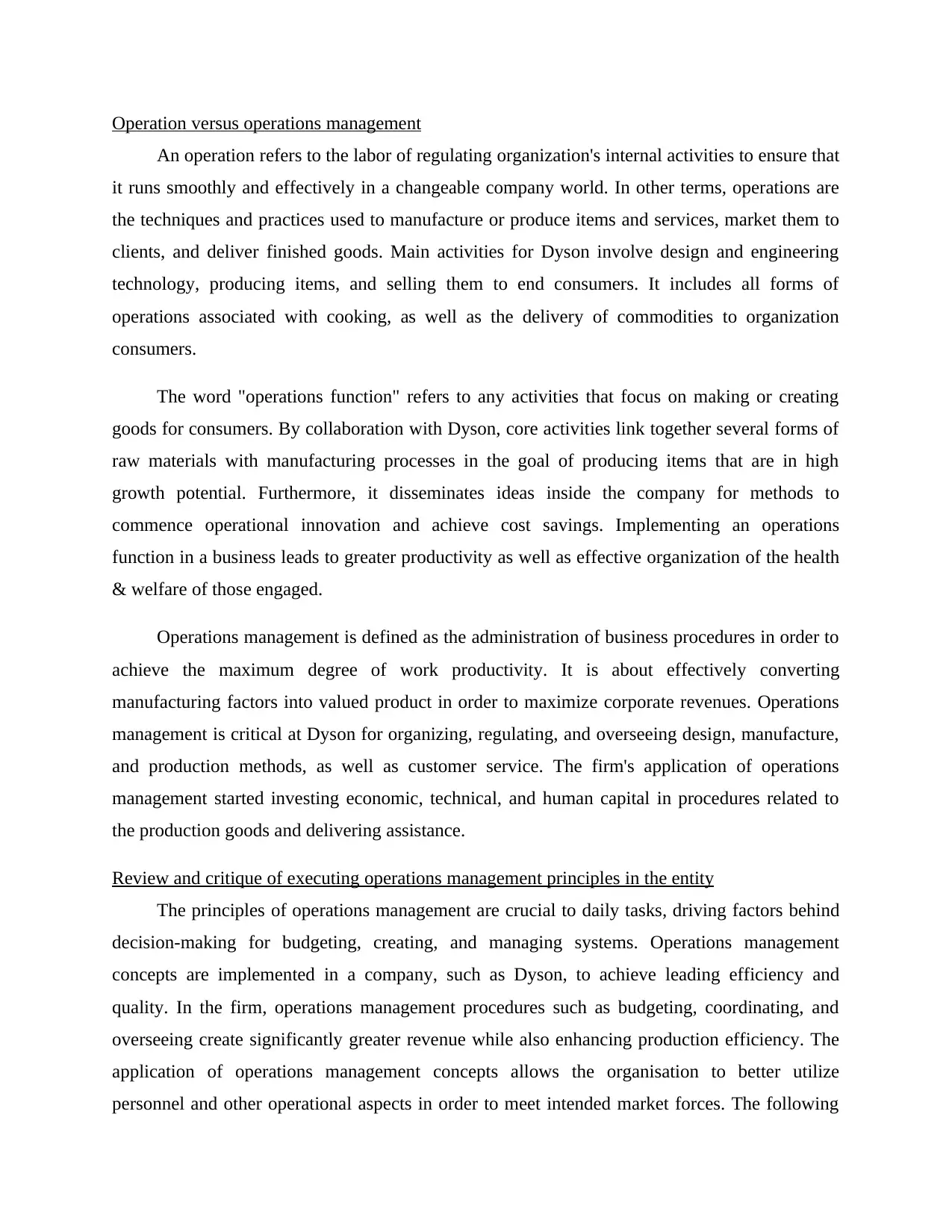
Operation versus operations management
An operation refers to the labor of regulating organization's internal activities to ensure that
it runs smoothly and effectively in a changeable company world. In other terms, operations are
the techniques and practices used to manufacture or produce items and services, market them to
clients, and deliver finished goods. Main activities for Dyson involve design and engineering
technology, producing items, and selling them to end consumers. It includes all forms of
operations associated with cooking, as well as the delivery of commodities to organization
consumers.
The word "operations function" refers to any activities that focus on making or creating
goods for consumers. By collaboration with Dyson, core activities link together several forms of
raw materials with manufacturing processes in the goal of producing items that are in high
growth potential. Furthermore, it disseminates ideas inside the company for methods to
commence operational innovation and achieve cost savings. Implementing an operations
function in a business leads to greater productivity as well as effective organization of the health
& welfare of those engaged.
Operations management is defined as the administration of business procedures in order to
achieve the maximum degree of work productivity. It is about effectively converting
manufacturing factors into valued product in order to maximize corporate revenues. Operations
management is critical at Dyson for organizing, regulating, and overseeing design, manufacture,
and production methods, as well as customer service. The firm's application of operations
management started investing economic, technical, and human capital in procedures related to
the production goods and delivering assistance.
Review and critique of executing operations management principles in the entity
The principles of operations management are crucial to daily tasks, driving factors behind
decision-making for budgeting, creating, and managing systems. Operations management
concepts are implemented in a company, such as Dyson, to achieve leading efficiency and
quality. In the firm, operations management procedures such as budgeting, coordinating, and
overseeing create significantly greater revenue while also enhancing production efficiency. The
application of operations management concepts allows the organisation to better utilize
personnel and other operational aspects in order to meet intended market forces. The following
An operation refers to the labor of regulating organization's internal activities to ensure that
it runs smoothly and effectively in a changeable company world. In other terms, operations are
the techniques and practices used to manufacture or produce items and services, market them to
clients, and deliver finished goods. Main activities for Dyson involve design and engineering
technology, producing items, and selling them to end consumers. It includes all forms of
operations associated with cooking, as well as the delivery of commodities to organization
consumers.
The word "operations function" refers to any activities that focus on making or creating
goods for consumers. By collaboration with Dyson, core activities link together several forms of
raw materials with manufacturing processes in the goal of producing items that are in high
growth potential. Furthermore, it disseminates ideas inside the company for methods to
commence operational innovation and achieve cost savings. Implementing an operations
function in a business leads to greater productivity as well as effective organization of the health
& welfare of those engaged.
Operations management is defined as the administration of business procedures in order to
achieve the maximum degree of work productivity. It is about effectively converting
manufacturing factors into valued product in order to maximize corporate revenues. Operations
management is critical at Dyson for organizing, regulating, and overseeing design, manufacture,
and production methods, as well as customer service. The firm's application of operations
management started investing economic, technical, and human capital in procedures related to
the production goods and delivering assistance.
Review and critique of executing operations management principles in the entity
The principles of operations management are crucial to daily tasks, driving factors behind
decision-making for budgeting, creating, and managing systems. Operations management
concepts are implemented in a company, such as Dyson, to achieve leading efficiency and
quality. In the firm, operations management procedures such as budgeting, coordinating, and
overseeing create significantly greater revenue while also enhancing production efficiency. The
application of operations management concepts allows the organisation to better utilize
personnel and other operational aspects in order to meet intended market forces. The following
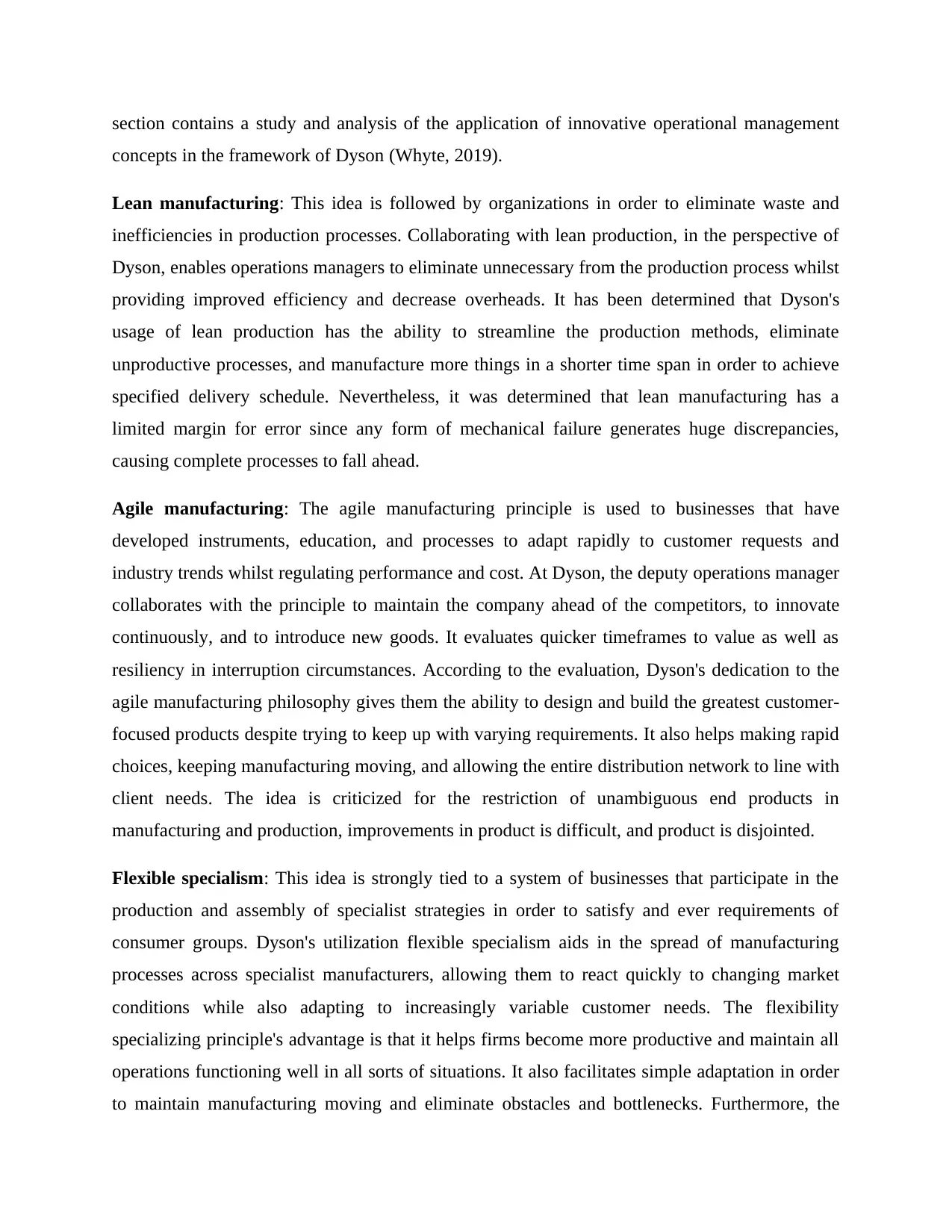
section contains a study and analysis of the application of innovative operational management
concepts in the framework of Dyson (Whyte, 2019).
Lean manufacturing: This idea is followed by organizations in order to eliminate waste and
inefficiencies in production processes. Collaborating with lean production, in the perspective of
Dyson, enables operations managers to eliminate unnecessary from the production process whilst
providing improved efficiency and decrease overheads. It has been determined that Dyson's
usage of lean production has the ability to streamline the production methods, eliminate
unproductive processes, and manufacture more things in a shorter time span in order to achieve
specified delivery schedule. Nevertheless, it was determined that lean manufacturing has a
limited margin for error since any form of mechanical failure generates huge discrepancies,
causing complete processes to fall ahead.
Agile manufacturing: The agile manufacturing principle is used to businesses that have
developed instruments, education, and processes to adapt rapidly to customer requests and
industry trends whilst regulating performance and cost. At Dyson, the deputy operations manager
collaborates with the principle to maintain the company ahead of the competitors, to innovate
continuously, and to introduce new goods. It evaluates quicker timeframes to value as well as
resiliency in interruption circumstances. According to the evaluation, Dyson's dedication to the
agile manufacturing philosophy gives them the ability to design and build the greatest customer-
focused products despite trying to keep up with varying requirements. It also helps making rapid
choices, keeping manufacturing moving, and allowing the entire distribution network to line with
client needs. The idea is criticized for the restriction of unambiguous end products in
manufacturing and production, improvements in product is difficult, and product is disjointed.
Flexible specialism: This idea is strongly tied to a system of businesses that participate in the
production and assembly of specialist strategies in order to satisfy and ever requirements of
consumer groups. Dyson's utilization flexible specialism aids in the spread of manufacturing
processes across specialist manufacturers, allowing them to react quickly to changing market
conditions while also adapting to increasingly variable customer needs. The flexibility
specializing principle's advantage is that it helps firms become more productive and maintain all
operations functioning well in all sorts of situations. It also facilitates simple adaptation in order
to maintain manufacturing moving and eliminate obstacles and bottlenecks. Furthermore, the
concepts in the framework of Dyson (Whyte, 2019).
Lean manufacturing: This idea is followed by organizations in order to eliminate waste and
inefficiencies in production processes. Collaborating with lean production, in the perspective of
Dyson, enables operations managers to eliminate unnecessary from the production process whilst
providing improved efficiency and decrease overheads. It has been determined that Dyson's
usage of lean production has the ability to streamline the production methods, eliminate
unproductive processes, and manufacture more things in a shorter time span in order to achieve
specified delivery schedule. Nevertheless, it was determined that lean manufacturing has a
limited margin for error since any form of mechanical failure generates huge discrepancies,
causing complete processes to fall ahead.
Agile manufacturing: The agile manufacturing principle is used to businesses that have
developed instruments, education, and processes to adapt rapidly to customer requests and
industry trends whilst regulating performance and cost. At Dyson, the deputy operations manager
collaborates with the principle to maintain the company ahead of the competitors, to innovate
continuously, and to introduce new goods. It evaluates quicker timeframes to value as well as
resiliency in interruption circumstances. According to the evaluation, Dyson's dedication to the
agile manufacturing philosophy gives them the ability to design and build the greatest customer-
focused products despite trying to keep up with varying requirements. It also helps making rapid
choices, keeping manufacturing moving, and allowing the entire distribution network to line with
client needs. The idea is criticized for the restriction of unambiguous end products in
manufacturing and production, improvements in product is difficult, and product is disjointed.
Flexible specialism: This idea is strongly tied to a system of businesses that participate in the
production and assembly of specialist strategies in order to satisfy and ever requirements of
consumer groups. Dyson's utilization flexible specialism aids in the spread of manufacturing
processes across specialist manufacturers, allowing them to react quickly to changing market
conditions while also adapting to increasingly variable customer needs. The flexibility
specializing principle's advantage is that it helps firms become more productive and maintain all
operations functioning well in all sorts of situations. It also facilitates simple adaptation in order
to maintain manufacturing moving and eliminate obstacles and bottlenecks. Furthermore, the
⊘ This is a preview!⊘
Do you want full access?
Subscribe today to unlock all pages.

Trusted by 1+ million students worldwide
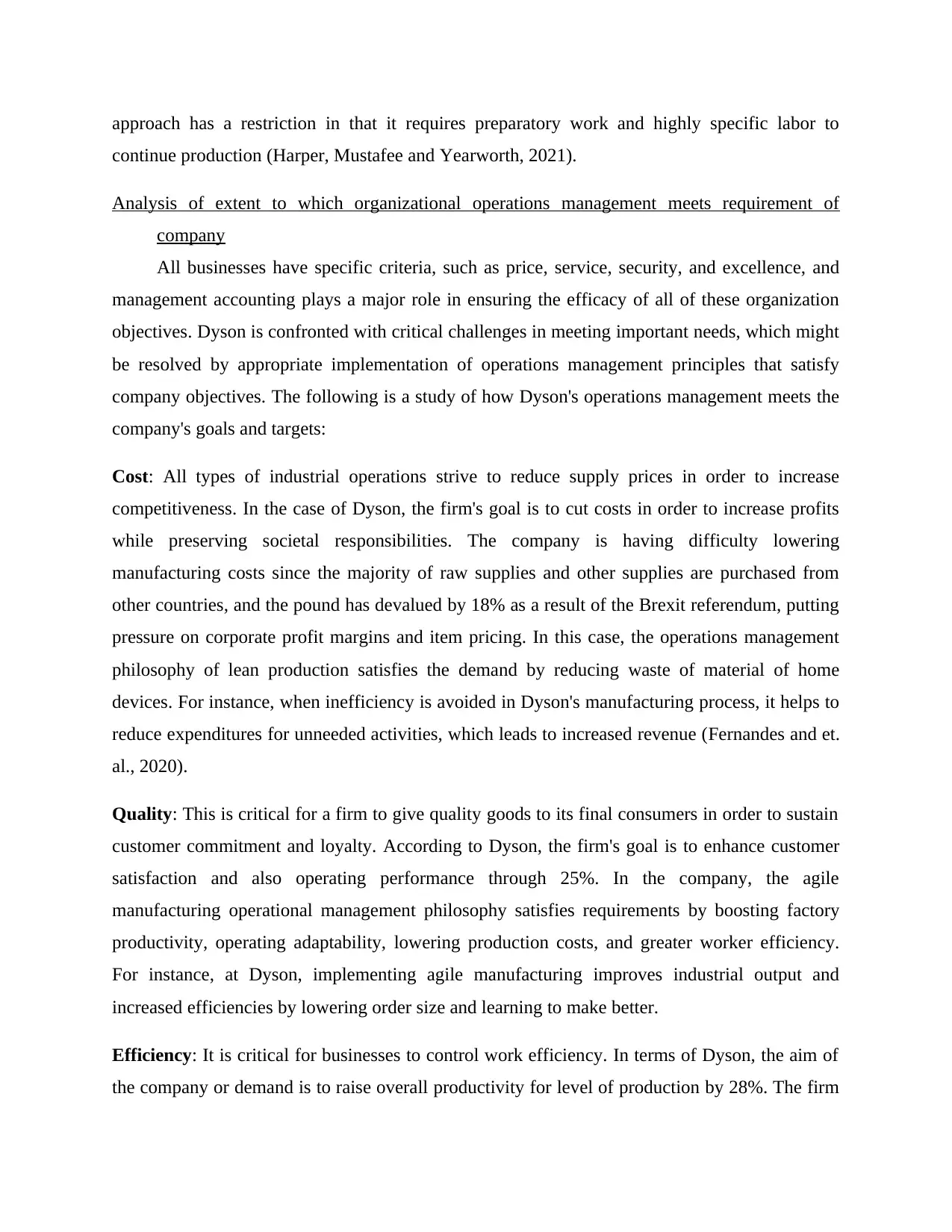
approach has a restriction in that it requires preparatory work and highly specific labor to
continue production (Harper, Mustafee and Yearworth, 2021).
Analysis of extent to which organizational operations management meets requirement of
company
All businesses have specific criteria, such as price, service, security, and excellence, and
management accounting plays a major role in ensuring the efficacy of all of these organization
objectives. Dyson is confronted with critical challenges in meeting important needs, which might
be resolved by appropriate implementation of operations management principles that satisfy
company objectives. The following is a study of how Dyson's operations management meets the
company's goals and targets:
Cost: All types of industrial operations strive to reduce supply prices in order to increase
competitiveness. In the case of Dyson, the firm's goal is to cut costs in order to increase profits
while preserving societal responsibilities. The company is having difficulty lowering
manufacturing costs since the majority of raw supplies and other supplies are purchased from
other countries, and the pound has devalued by 18% as a result of the Brexit referendum, putting
pressure on corporate profit margins and item pricing. In this case, the operations management
philosophy of lean production satisfies the demand by reducing waste of material of home
devices. For instance, when inefficiency is avoided in Dyson's manufacturing process, it helps to
reduce expenditures for unneeded activities, which leads to increased revenue (Fernandes and et.
al., 2020).
Quality: This is critical for a firm to give quality goods to its final consumers in order to sustain
customer commitment and loyalty. According to Dyson, the firm's goal is to enhance customer
satisfaction and also operating performance through 25%. In the company, the agile
manufacturing operational management philosophy satisfies requirements by boosting factory
productivity, operating adaptability, lowering production costs, and greater worker efficiency.
For instance, at Dyson, implementing agile manufacturing improves industrial output and
increased efficiencies by lowering order size and learning to make better.
Efficiency: It is critical for businesses to control work efficiency. In terms of Dyson, the aim of
the company or demand is to raise overall productivity for level of production by 28%. The firm
continue production (Harper, Mustafee and Yearworth, 2021).
Analysis of extent to which organizational operations management meets requirement of
company
All businesses have specific criteria, such as price, service, security, and excellence, and
management accounting plays a major role in ensuring the efficacy of all of these organization
objectives. Dyson is confronted with critical challenges in meeting important needs, which might
be resolved by appropriate implementation of operations management principles that satisfy
company objectives. The following is a study of how Dyson's operations management meets the
company's goals and targets:
Cost: All types of industrial operations strive to reduce supply prices in order to increase
competitiveness. In the case of Dyson, the firm's goal is to cut costs in order to increase profits
while preserving societal responsibilities. The company is having difficulty lowering
manufacturing costs since the majority of raw supplies and other supplies are purchased from
other countries, and the pound has devalued by 18% as a result of the Brexit referendum, putting
pressure on corporate profit margins and item pricing. In this case, the operations management
philosophy of lean production satisfies the demand by reducing waste of material of home
devices. For instance, when inefficiency is avoided in Dyson's manufacturing process, it helps to
reduce expenditures for unneeded activities, which leads to increased revenue (Fernandes and et.
al., 2020).
Quality: This is critical for a firm to give quality goods to its final consumers in order to sustain
customer commitment and loyalty. According to Dyson, the firm's goal is to enhance customer
satisfaction and also operating performance through 25%. In the company, the agile
manufacturing operational management philosophy satisfies requirements by boosting factory
productivity, operating adaptability, lowering production costs, and greater worker efficiency.
For instance, at Dyson, implementing agile manufacturing improves industrial output and
increased efficiencies by lowering order size and learning to make better.
Efficiency: It is critical for businesses to control work efficiency. In terms of Dyson, the aim of
the company or demand is to raise overall productivity for level of production by 28%. The firm
Paraphrase This Document
Need a fresh take? Get an instant paraphrase of this document with our AI Paraphraser
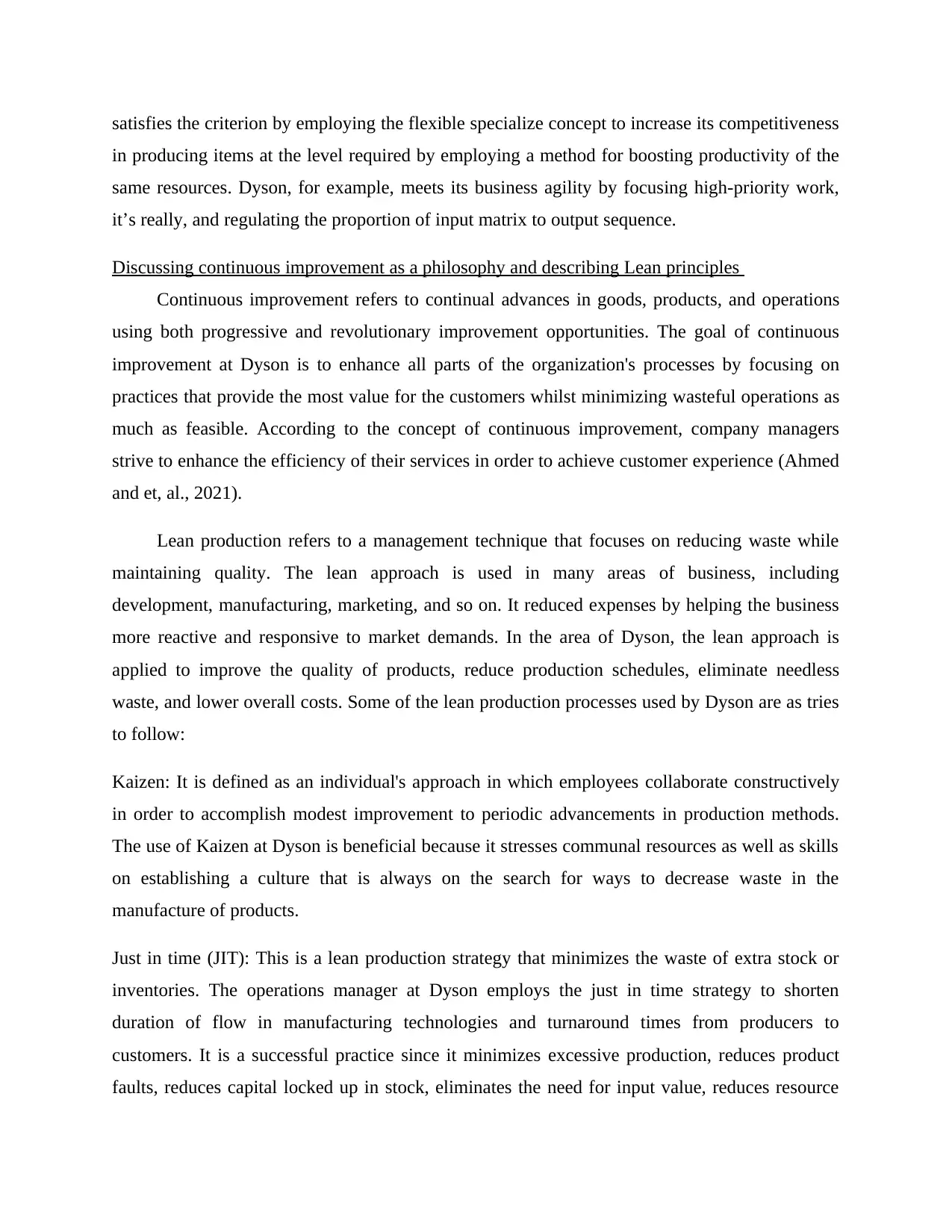
satisfies the criterion by employing the flexible specialize concept to increase its competitiveness
in producing items at the level required by employing a method for boosting productivity of the
same resources. Dyson, for example, meets its business agility by focusing high-priority work,
it’s really, and regulating the proportion of input matrix to output sequence.
Discussing continuous improvement as a philosophy and describing Lean principles
Continuous improvement refers to continual advances in goods, products, and operations
using both progressive and revolutionary improvement opportunities. The goal of continuous
improvement at Dyson is to enhance all parts of the organization's processes by focusing on
practices that provide the most value for the customers whilst minimizing wasteful operations as
much as feasible. According to the concept of continuous improvement, company managers
strive to enhance the efficiency of their services in order to achieve customer experience (Ahmed
and et, al., 2021).
Lean production refers to a management technique that focuses on reducing waste while
maintaining quality. The lean approach is used in many areas of business, including
development, manufacturing, marketing, and so on. It reduced expenses by helping the business
more reactive and responsive to market demands. In the area of Dyson, the lean approach is
applied to improve the quality of products, reduce production schedules, eliminate needless
waste, and lower overall costs. Some of the lean production processes used by Dyson are as tries
to follow:
Kaizen: It is defined as an individual's approach in which employees collaborate constructively
in order to accomplish modest improvement to periodic advancements in production methods.
The use of Kaizen at Dyson is beneficial because it stresses communal resources as well as skills
on establishing a culture that is always on the search for ways to decrease waste in the
manufacture of products.
Just in time (JIT): This is a lean production strategy that minimizes the waste of extra stock or
inventories. The operations manager at Dyson employs the just in time strategy to shorten
duration of flow in manufacturing technologies and turnaround times from producers to
customers. It is a successful practice since it minimizes excessive production, reduces product
faults, reduces capital locked up in stock, eliminates the need for input value, reduces resource
in producing items at the level required by employing a method for boosting productivity of the
same resources. Dyson, for example, meets its business agility by focusing high-priority work,
it’s really, and regulating the proportion of input matrix to output sequence.
Discussing continuous improvement as a philosophy and describing Lean principles
Continuous improvement refers to continual advances in goods, products, and operations
using both progressive and revolutionary improvement opportunities. The goal of continuous
improvement at Dyson is to enhance all parts of the organization's processes by focusing on
practices that provide the most value for the customers whilst minimizing wasteful operations as
much as feasible. According to the concept of continuous improvement, company managers
strive to enhance the efficiency of their services in order to achieve customer experience (Ahmed
and et, al., 2021).
Lean production refers to a management technique that focuses on reducing waste while
maintaining quality. The lean approach is used in many areas of business, including
development, manufacturing, marketing, and so on. It reduced expenses by helping the business
more reactive and responsive to market demands. In the area of Dyson, the lean approach is
applied to improve the quality of products, reduce production schedules, eliminate needless
waste, and lower overall costs. Some of the lean production processes used by Dyson are as tries
to follow:
Kaizen: It is defined as an individual's approach in which employees collaborate constructively
in order to accomplish modest improvement to periodic advancements in production methods.
The use of Kaizen at Dyson is beneficial because it stresses communal resources as well as skills
on establishing a culture that is always on the search for ways to decrease waste in the
manufacture of products.
Just in time (JIT): This is a lean production strategy that minimizes the waste of extra stock or
inventories. The operations manager at Dyson employs the just in time strategy to shorten
duration of flow in manufacturing technologies and turnaround times from producers to
customers. It is a successful practice since it minimizes excessive production, reduces product
faults, reduces capital locked up in stock, eliminates the need for input value, reduces resource
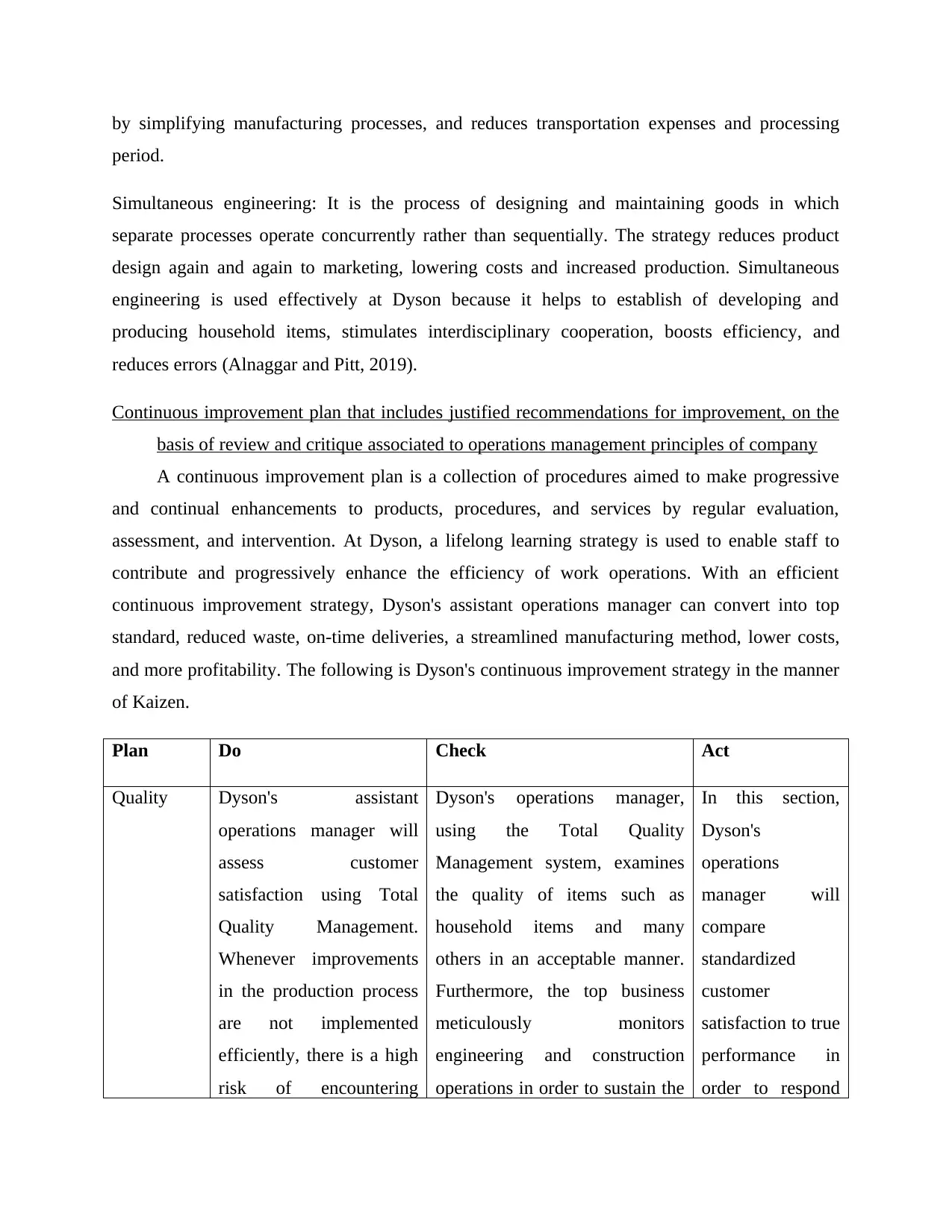
by simplifying manufacturing processes, and reduces transportation expenses and processing
period.
Simultaneous engineering: It is the process of designing and maintaining goods in which
separate processes operate concurrently rather than sequentially. The strategy reduces product
design again and again to marketing, lowering costs and increased production. Simultaneous
engineering is used effectively at Dyson because it helps to establish of developing and
producing household items, stimulates interdisciplinary cooperation, boosts efficiency, and
reduces errors (Alnaggar and Pitt, 2019).
Continuous improvement plan that includes justified recommendations for improvement, on the
basis of review and critique associated to operations management principles of company
A continuous improvement plan is a collection of procedures aimed to make progressive
and continual enhancements to products, procedures, and services by regular evaluation,
assessment, and intervention. At Dyson, a lifelong learning strategy is used to enable staff to
contribute and progressively enhance the efficiency of work operations. With an efficient
continuous improvement strategy, Dyson's assistant operations manager can convert into top
standard, reduced waste, on-time deliveries, a streamlined manufacturing method, lower costs,
and more profitability. The following is Dyson's continuous improvement strategy in the manner
of Kaizen.
Plan Do Check Act
Quality Dyson's assistant
operations manager will
assess customer
satisfaction using Total
Quality Management.
Whenever improvements
in the production process
are not implemented
efficiently, there is a high
risk of encountering
Dyson's operations manager,
using the Total Quality
Management system, examines
the quality of items such as
household items and many
others in an acceptable manner.
Furthermore, the top business
meticulously monitors
engineering and construction
operations in order to sustain the
In this section,
Dyson's
operations
manager will
compare
standardized
customer
satisfaction to true
performance in
order to respond
period.
Simultaneous engineering: It is the process of designing and maintaining goods in which
separate processes operate concurrently rather than sequentially. The strategy reduces product
design again and again to marketing, lowering costs and increased production. Simultaneous
engineering is used effectively at Dyson because it helps to establish of developing and
producing household items, stimulates interdisciplinary cooperation, boosts efficiency, and
reduces errors (Alnaggar and Pitt, 2019).
Continuous improvement plan that includes justified recommendations for improvement, on the
basis of review and critique associated to operations management principles of company
A continuous improvement plan is a collection of procedures aimed to make progressive
and continual enhancements to products, procedures, and services by regular evaluation,
assessment, and intervention. At Dyson, a lifelong learning strategy is used to enable staff to
contribute and progressively enhance the efficiency of work operations. With an efficient
continuous improvement strategy, Dyson's assistant operations manager can convert into top
standard, reduced waste, on-time deliveries, a streamlined manufacturing method, lower costs,
and more profitability. The following is Dyson's continuous improvement strategy in the manner
of Kaizen.
Plan Do Check Act
Quality Dyson's assistant
operations manager will
assess customer
satisfaction using Total
Quality Management.
Whenever improvements
in the production process
are not implemented
efficiently, there is a high
risk of encountering
Dyson's operations manager,
using the Total Quality
Management system, examines
the quality of items such as
household items and many
others in an acceptable manner.
Furthermore, the top business
meticulously monitors
engineering and construction
operations in order to sustain the
In this section,
Dyson's
operations
manager will
compare
standardized
customer
satisfaction to true
performance in
order to respond
⊘ This is a preview!⊘
Do you want full access?
Subscribe today to unlock all pages.

Trusted by 1+ million students worldwide
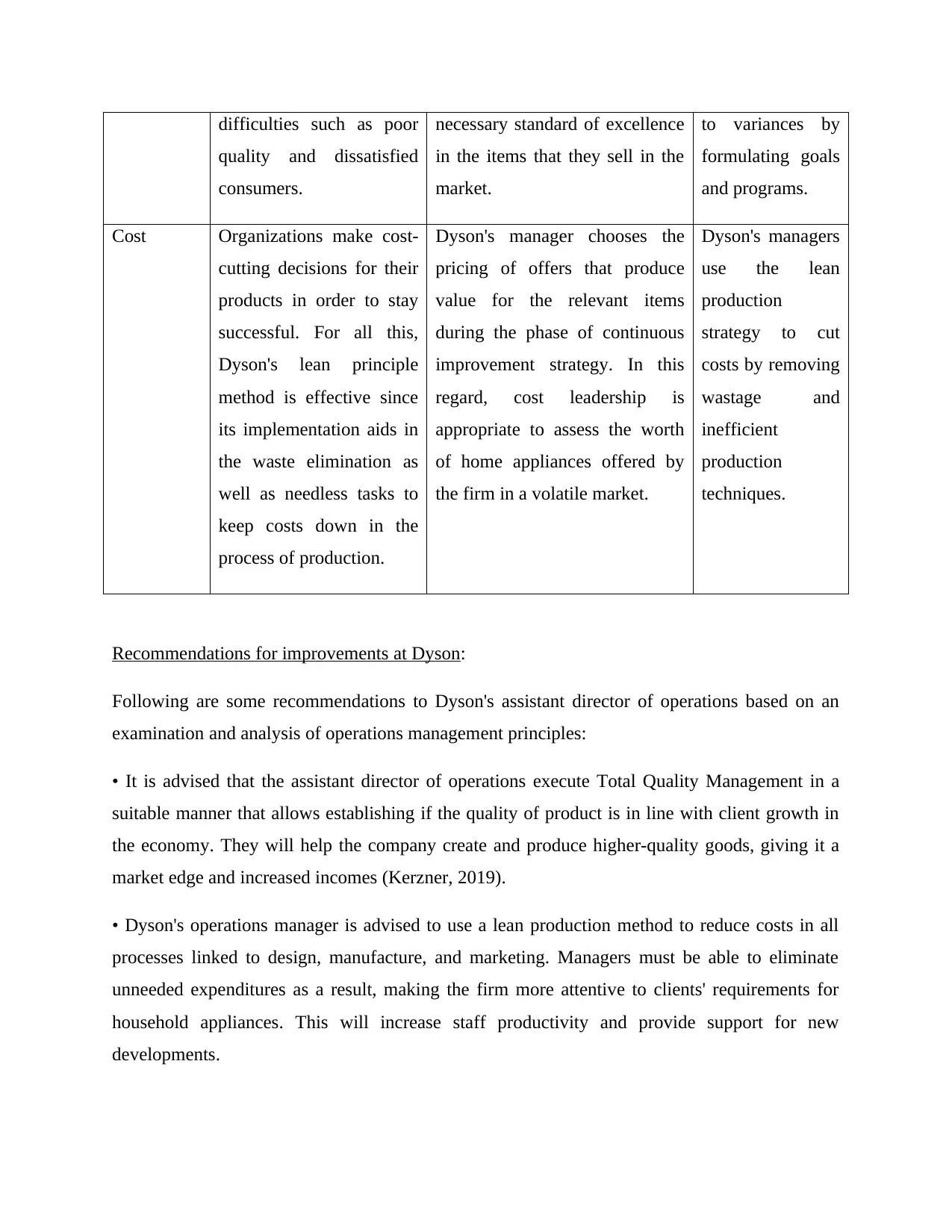
difficulties such as poor
quality and dissatisfied
consumers.
necessary standard of excellence
in the items that they sell in the
market.
to variances by
formulating goals
and programs.
Cost Organizations make cost-
cutting decisions for their
products in order to stay
successful. For all this,
Dyson's lean principle
method is effective since
its implementation aids in
the waste elimination as
well as needless tasks to
keep costs down in the
process of production.
Dyson's manager chooses the
pricing of offers that produce
value for the relevant items
during the phase of continuous
improvement strategy. In this
regard, cost leadership is
appropriate to assess the worth
of home appliances offered by
the firm in a volatile market.
Dyson's managers
use the lean
production
strategy to cut
costs by removing
wastage and
inefficient
production
techniques.
Recommendations for improvements at Dyson:
Following are some recommendations to Dyson's assistant director of operations based on an
examination and analysis of operations management principles:
• It is advised that the assistant director of operations execute Total Quality Management in a
suitable manner that allows establishing if the quality of product is in line with client growth in
the economy. They will help the company create and produce higher-quality goods, giving it a
market edge and increased incomes (Kerzner, 2019).
• Dyson's operations manager is advised to use a lean production method to reduce costs in all
processes linked to design, manufacture, and marketing. Managers must be able to eliminate
unneeded expenditures as a result, making the firm more attentive to clients' requirements for
household appliances. This will increase staff productivity and provide support for new
developments.
quality and dissatisfied
consumers.
necessary standard of excellence
in the items that they sell in the
market.
to variances by
formulating goals
and programs.
Cost Organizations make cost-
cutting decisions for their
products in order to stay
successful. For all this,
Dyson's lean principle
method is effective since
its implementation aids in
the waste elimination as
well as needless tasks to
keep costs down in the
process of production.
Dyson's manager chooses the
pricing of offers that produce
value for the relevant items
during the phase of continuous
improvement strategy. In this
regard, cost leadership is
appropriate to assess the worth
of home appliances offered by
the firm in a volatile market.
Dyson's managers
use the lean
production
strategy to cut
costs by removing
wastage and
inefficient
production
techniques.
Recommendations for improvements at Dyson:
Following are some recommendations to Dyson's assistant director of operations based on an
examination and analysis of operations management principles:
• It is advised that the assistant director of operations execute Total Quality Management in a
suitable manner that allows establishing if the quality of product is in line with client growth in
the economy. They will help the company create and produce higher-quality goods, giving it a
market edge and increased incomes (Kerzner, 2019).
• Dyson's operations manager is advised to use a lean production method to reduce costs in all
processes linked to design, manufacture, and marketing. Managers must be able to eliminate
unneeded expenditures as a result, making the firm more attentive to clients' requirements for
household appliances. This will increase staff productivity and provide support for new
developments.
Paraphrase This Document
Need a fresh take? Get an instant paraphrase of this document with our AI Paraphraser
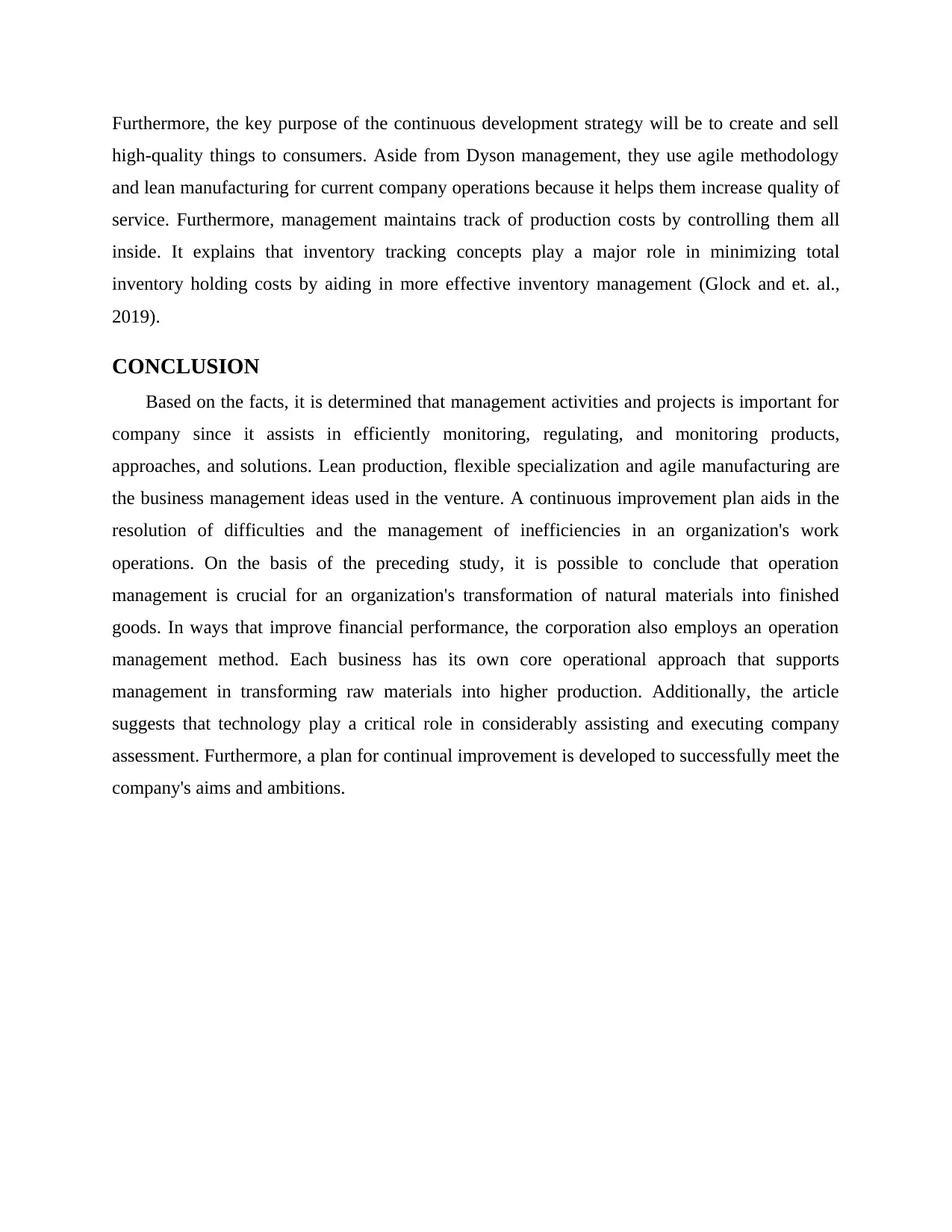
Furthermore, the key purpose of the continuous development strategy will be to create and sell
high-quality things to consumers. Aside from Dyson management, they use agile methodology
and lean manufacturing for current company operations because it helps them increase quality of
service. Furthermore, management maintains track of production costs by controlling them all
inside. It explains that inventory tracking concepts play a major role in minimizing total
inventory holding costs by aiding in more effective inventory management (Glock and et. al.,
2019).
CONCLUSION
Based on the facts, it is determined that management activities and projects is important for
company since it assists in efficiently monitoring, regulating, and monitoring products,
approaches, and solutions. Lean production, flexible specialization and agile manufacturing are
the business management ideas used in the venture. A continuous improvement plan aids in the
resolution of difficulties and the management of inefficiencies in an organization's work
operations. On the basis of the preceding study, it is possible to conclude that operation
management is crucial for an organization's transformation of natural materials into finished
goods. In ways that improve financial performance, the corporation also employs an operation
management method. Each business has its own core operational approach that supports
management in transforming raw materials into higher production. Additionally, the article
suggests that technology play a critical role in considerably assisting and executing company
assessment. Furthermore, a plan for continual improvement is developed to successfully meet the
company's aims and ambitions.
high-quality things to consumers. Aside from Dyson management, they use agile methodology
and lean manufacturing for current company operations because it helps them increase quality of
service. Furthermore, management maintains track of production costs by controlling them all
inside. It explains that inventory tracking concepts play a major role in minimizing total
inventory holding costs by aiding in more effective inventory management (Glock and et. al.,
2019).
CONCLUSION
Based on the facts, it is determined that management activities and projects is important for
company since it assists in efficiently monitoring, regulating, and monitoring products,
approaches, and solutions. Lean production, flexible specialization and agile manufacturing are
the business management ideas used in the venture. A continuous improvement plan aids in the
resolution of difficulties and the management of inefficiencies in an organization's work
operations. On the basis of the preceding study, it is possible to conclude that operation
management is crucial for an organization's transformation of natural materials into finished
goods. In ways that improve financial performance, the corporation also employs an operation
management method. Each business has its own core operational approach that supports
management in transforming raw materials into higher production. Additionally, the article
suggests that technology play a critical role in considerably assisting and executing company
assessment. Furthermore, a plan for continual improvement is developed to successfully meet the
company's aims and ambitions.
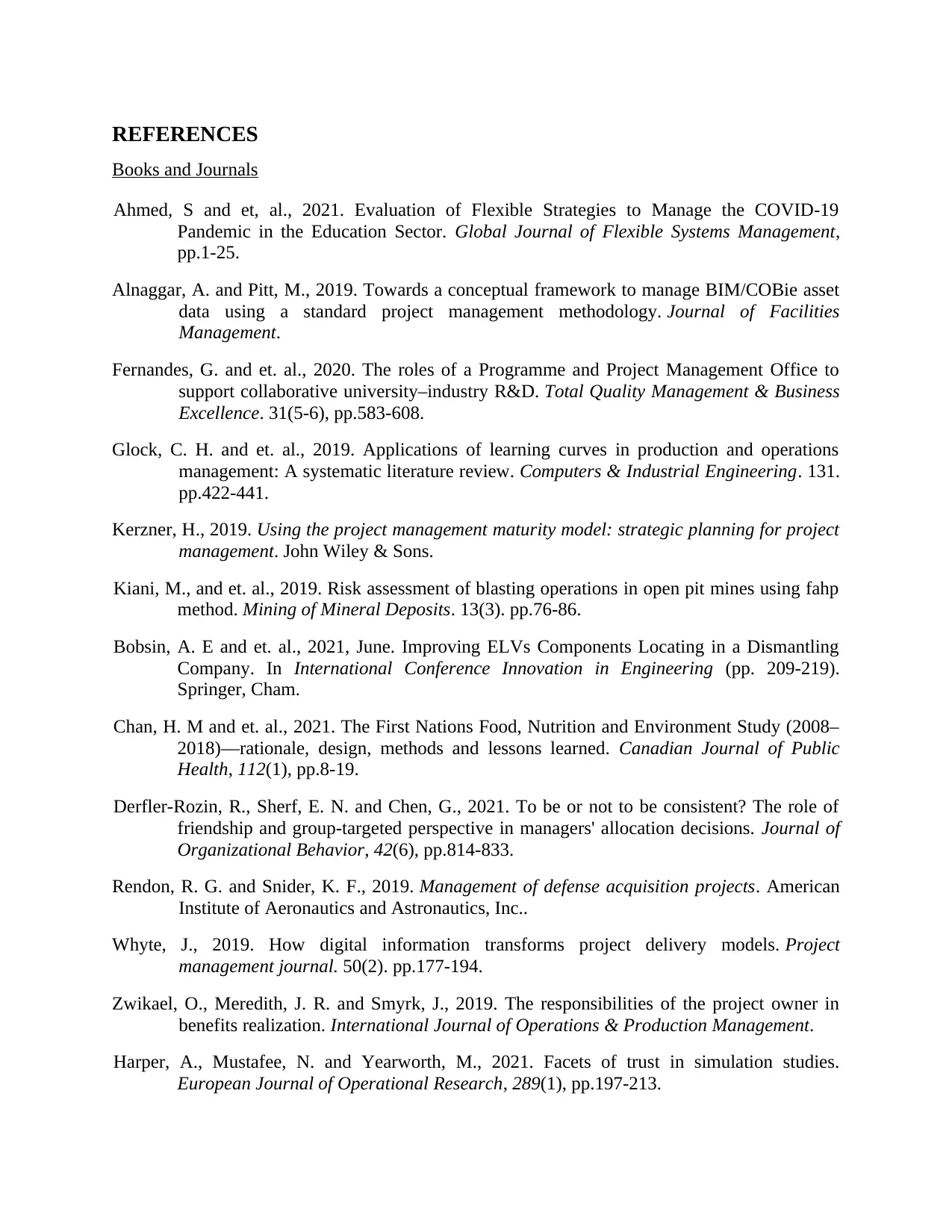
REFERENCES
Books and Journals
Ahmed, S and et, al., 2021. Evaluation of Flexible Strategies to Manage the COVID-19
Pandemic in the Education Sector. Global Journal of Flexible Systems Management,
pp.1-25.
Alnaggar, A. and Pitt, M., 2019. Towards a conceptual framework to manage BIM/COBie asset
data using a standard project management methodology. Journal of Facilities
Management.
Fernandes, G. and et. al., 2020. The roles of a Programme and Project Management Office to
support collaborative university–industry R&D. Total Quality Management & Business
Excellence. 31(5-6), pp.583-608.
Glock, C. H. and et. al., 2019. Applications of learning curves in production and operations
management: A systematic literature review. Computers & Industrial Engineering. 131.
pp.422-441.
Kerzner, H., 2019. Using the project management maturity model: strategic planning for project
management. John Wiley & Sons.
Kiani, M., and et. al., 2019. Risk assessment of blasting operations in open pit mines using fahp
method. Mining of Mineral Deposits. 13(3). pp.76-86.
Bobsin, A. E and et. al., 2021, June. Improving ELVs Components Locating in a Dismantling
Company. In International Conference Innovation in Engineering (pp. 209-219).
Springer, Cham.
Chan, H. M and et. al., 2021. The First Nations Food, Nutrition and Environment Study (2008–
2018)—rationale, design, methods and lessons learned. Canadian Journal of Public
Health, 112(1), pp.8-19.
Derfler-Rozin, R., Sherf, E. N. and Chen, G., 2021. To be or not to be consistent? The role of
friendship and group-targeted perspective in managers' allocation decisions. Journal of
Organizational Behavior, 42(6), pp.814-833.
Rendon, R. G. and Snider, K. F., 2019. Management of defense acquisition projects. American
Institute of Aeronautics and Astronautics, Inc..
Whyte, J., 2019. How digital information transforms project delivery models. Project
management journal. 50(2). pp.177-194.
Zwikael, O., Meredith, J. R. and Smyrk, J., 2019. The responsibilities of the project owner in
benefits realization. International Journal of Operations & Production Management.
Harper, A., Mustafee, N. and Yearworth, M., 2021. Facets of trust in simulation studies.
European Journal of Operational Research, 289(1), pp.197-213.
Books and Journals
Ahmed, S and et, al., 2021. Evaluation of Flexible Strategies to Manage the COVID-19
Pandemic in the Education Sector. Global Journal of Flexible Systems Management,
pp.1-25.
Alnaggar, A. and Pitt, M., 2019. Towards a conceptual framework to manage BIM/COBie asset
data using a standard project management methodology. Journal of Facilities
Management.
Fernandes, G. and et. al., 2020. The roles of a Programme and Project Management Office to
support collaborative university–industry R&D. Total Quality Management & Business
Excellence. 31(5-6), pp.583-608.
Glock, C. H. and et. al., 2019. Applications of learning curves in production and operations
management: A systematic literature review. Computers & Industrial Engineering. 131.
pp.422-441.
Kerzner, H., 2019. Using the project management maturity model: strategic planning for project
management. John Wiley & Sons.
Kiani, M., and et. al., 2019. Risk assessment of blasting operations in open pit mines using fahp
method. Mining of Mineral Deposits. 13(3). pp.76-86.
Bobsin, A. E and et. al., 2021, June. Improving ELVs Components Locating in a Dismantling
Company. In International Conference Innovation in Engineering (pp. 209-219).
Springer, Cham.
Chan, H. M and et. al., 2021. The First Nations Food, Nutrition and Environment Study (2008–
2018)—rationale, design, methods and lessons learned. Canadian Journal of Public
Health, 112(1), pp.8-19.
Derfler-Rozin, R., Sherf, E. N. and Chen, G., 2021. To be or not to be consistent? The role of
friendship and group-targeted perspective in managers' allocation decisions. Journal of
Organizational Behavior, 42(6), pp.814-833.
Rendon, R. G. and Snider, K. F., 2019. Management of defense acquisition projects. American
Institute of Aeronautics and Astronautics, Inc..
Whyte, J., 2019. How digital information transforms project delivery models. Project
management journal. 50(2). pp.177-194.
Zwikael, O., Meredith, J. R. and Smyrk, J., 2019. The responsibilities of the project owner in
benefits realization. International Journal of Operations & Production Management.
Harper, A., Mustafee, N. and Yearworth, M., 2021. Facets of trust in simulation studies.
European Journal of Operational Research, 289(1), pp.197-213.
⊘ This is a preview!⊘
Do you want full access?
Subscribe today to unlock all pages.

Trusted by 1+ million students worldwide
1 out of 20
Related Documents
Your All-in-One AI-Powered Toolkit for Academic Success.
+13062052269
info@desklib.com
Available 24*7 on WhatsApp / Email
![[object Object]](/_next/static/media/star-bottom.7253800d.svg)
Unlock your academic potential
Copyright © 2020–2025 A2Z Services. All Rights Reserved. Developed and managed by ZUCOL.



